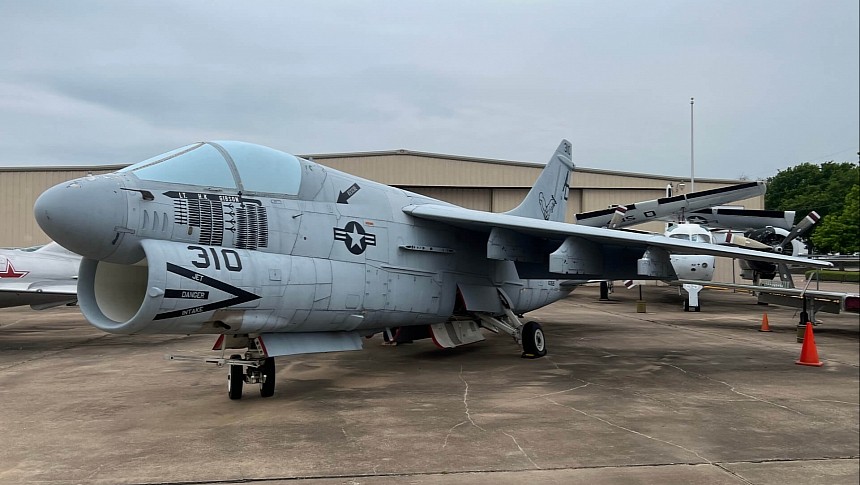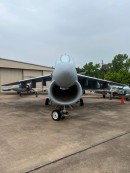What's the first thing that comes to your mind when a clapped-out old jalopy of an automobile is strewn out over someone's front lawn in a particularly rough part of town? Would you wonder why the owner seems not to have a problem with a rusting, useless hulk of scrap rotting away for all to see on their front grass? Or do you pass it off as just another day in the neighborhood? Well, this LTV A-7E Corsair II is about as practically useful as the above-mentioned old beater sitting on cinderblocks on someone's lawn. It must be said, it's considerably more fascinating.
A product of the Ling Temco Vaught conglomerate which traces its roots back to the classic F4U Corsair of World War II fame, the A-7 Corsair II was one of the most advanced, most capable attack jets in the world in its day. Its origins date back to a U.S. Navy initiative to replace the Douglas A-4 Skyhawk attack jet, an aircraft that the Corsair ironically served alongside in the Navy during the War in Vietnam. Though not inherently supersonic like the F-8 Crusader LTV developed alongside the A-7, the Corsair was arguably more multi-functional.
With the ability to carry both air-to-air and air-to-ground ordnance and a fancy terrain-following radar system optimized for ground attack operations, there weren't too many roles out there that the Corsair II couldn't satisfy in a pinch. Powered by a single Allison TF41 turbojet derived from the British Rolls-Royce Spey, the Corsair II continued to operate with the U.S. Navy until the early 1990s and wouldn't be retired outright until 2014, when it was finally relieved of duty by the Hellenic Navy. This particular A-7E Corsair II was manufactured in 1964 and delivered to the U.S. Navy in early 1966, just in time for the escalation of hostilities in North Vietnam.
The jet served with the crews of the a number of different U.S. Navy aircraft carriers during its day. But as it sits right now, this jet sports the same markings it sported while in servive with the USS John F. Kennedy (CV-67), the final conventionally powered U.S. Navy aircraft carrier manufactured before the entire fleet opted for nuclear propulsion with the advent of the Nimitz class carriers following the conclusion of the 1960s. This A-7E operated with Attack Squadron 46 (VA-46) during the Navy's participation in Operation Desert Storm in the early 1990s, and the markings it sports today, even in its stripped-out form, is identical to how it looked while working on the deck of the USS JFK.
Though undoubtedly never taking to the air ever again, the asking price of $50,000 is a small one to pay for the eccentric millionaire looking for a fun conversation piece to chat about with their other, equally wealthy friends in their backyard garden parties. But, more likely, it's bound to end up at a museum for us common folks to look at and enjoy. If you ask us, the latter option a much better use of such a wonderful airframe.
With the ability to carry both air-to-air and air-to-ground ordnance and a fancy terrain-following radar system optimized for ground attack operations, there weren't too many roles out there that the Corsair II couldn't satisfy in a pinch. Powered by a single Allison TF41 turbojet derived from the British Rolls-Royce Spey, the Corsair II continued to operate with the U.S. Navy until the early 1990s and wouldn't be retired outright until 2014, when it was finally relieved of duty by the Hellenic Navy. This particular A-7E Corsair II was manufactured in 1964 and delivered to the U.S. Navy in early 1966, just in time for the escalation of hostilities in North Vietnam.
The jet served with the crews of the a number of different U.S. Navy aircraft carriers during its day. But as it sits right now, this jet sports the same markings it sported while in servive with the USS John F. Kennedy (CV-67), the final conventionally powered U.S. Navy aircraft carrier manufactured before the entire fleet opted for nuclear propulsion with the advent of the Nimitz class carriers following the conclusion of the 1960s. This A-7E operated with Attack Squadron 46 (VA-46) during the Navy's participation in Operation Desert Storm in the early 1990s, and the markings it sports today, even in its stripped-out form, is identical to how it looked while working on the deck of the USS JFK.
Though undoubtedly never taking to the air ever again, the asking price of $50,000 is a small one to pay for the eccentric millionaire looking for a fun conversation piece to chat about with their other, equally wealthy friends in their backyard garden parties. But, more likely, it's bound to end up at a museum for us common folks to look at and enjoy. If you ask us, the latter option a much better use of such a wonderful airframe.











